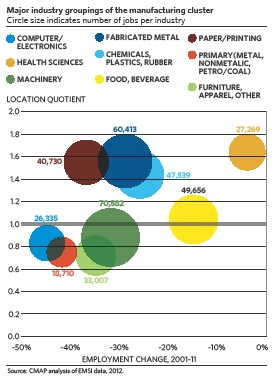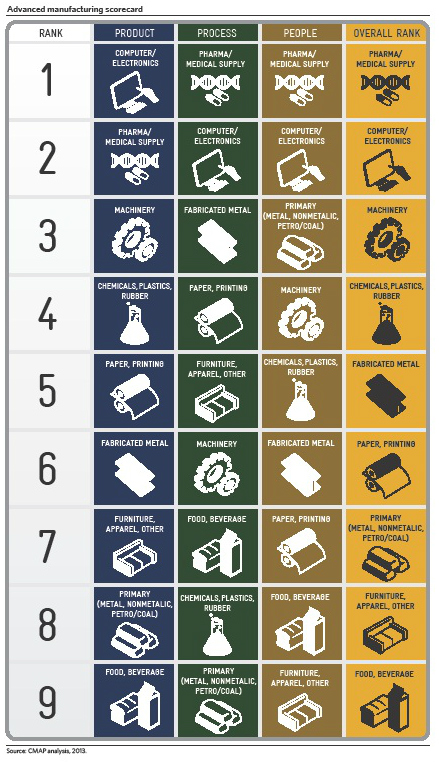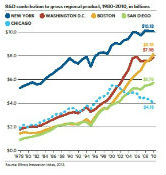What the next decade of Chicago manufacturing should look like
By Niala Boodhoo

What the next decade of Chicago manufacturing should look like
By Niala BoodhooAdvanced manufacturing is sort of a holy grail in economic development, even more so in the Midwest. These are the types of jobs President Obama talks about when he says we need to bring these jobs back to the United States: the new, high-tech manufacturing jobs that pay well, boost our exports and help create other supporting jobs.
Even after the loss of manufacturing jobs during the recession, the industry still accounts for a significant portion of the local labor market. More than 580,000 workers in the Chicago region, the second largest such cluster in the nation, according to a new report to be released today by the Chicago Metropolitan Agency for Planning. It also highlights the challenges for maintaining the region’s importance in manufacturing.
“We see a real manufacturing moment right now,” said Garett Ballard-Rosa, a CMAP policy analyst who worked on the report. “What we really show in this report is how we see the next ten years of manufacturing are going to look really different from the last ten.”
When they talk about the manufacturing cluster, that refers to a variety of industries, from biotech to pharmaceuticals to electronics. Unlike areas like Boston or San Francisco, the manufacturing throughout the Chicago region occurs across a variety of industries.

As you can see from the chart, there are a wide range of types of manufacturers and the concentration of employment within has changed in the past decade.
Chicago differs from other cities or parts of the country - think auto manufacturing and the Detroit region, for example - in that manufacturing here isn’t just concentrated in one type of product.
That presents challenges in a way, because Chicago isn’t known for producing one type of product. More on that diversity later - and how it has affected in particular, research and development funding.
But first, back to advanced manufacturing. Lots of people tout advanced manufacturing without provide specifics. The report attempts to change that by providing actual definitions for what advanced manufacturing is – namely, it suggests that “advanced manufacturing” contains complex products that are difficult to replicate, involves a process continuously that gets updated and requires workers with specialized skills.
The authors then attempted to use those three factors: product, process and people, to rank current industries, like pharmaceuticals, for example, or furniture construction, in terms of how “advanced” it actually is.
They then created a scorecard of how the industries ranked: not suprisingly, pharmaceutical and medical supply manufacturing ranked highest; computer/electronics came in next. Fabricated metals were in the middle, and food and beverage manufacturing came in last.
Here’s a helpful “scorecard” that was developed to divide the industries.

Workforce challenges are, of course, also something that is often talked about in regards to manufacturing. That’s what economists and others like to refer to as the “skills mismatch” – the idea that while there are plenty of unemployed workers, and plenty of openings, but the two don’t fit. Finding and training skilled workers remains one of the biggest challenges to the industry, according to the report.
Another main challenge involves research and development funding. Historically, Chicago had been one of the top centers for manufacturing research and development. Consider this: in 2000, the Chicago region’s private R&D output was 40 percent larger than Boston’s. Chicago consistently ranked number two in the country.

One important thing to know about the region’s manufacturing companies that is many are small firms, with less than 50 employees. Often, they don’t have large research and development budgets.
Ballard-Rosa suggests Chicago does have one unique advantage over most other major cities. Not only do we have major universities with a large research presence, but we are also home to two national laboratories. While the goal of Fermi and Argonne Labs is to conduct scientific research – not produce commercial products – Ballard-Rosa and others suggested that local government could act as an intermediary between private manufacturers here and the labs.
Argonne National Laboratory Director Eric Isaacs said while the focus will always be on providing national research, there is room for more cooperation with local companies.
“We as a laboratory I think are just realizing the value of having a local focus, too,” said Isaacs, who was at the University of Chicago before taking over at Argonne a few years ago. “And so I think you’ll see a lot more coming from the laboratory in the coming years, we’re looking to build up not just small companies but also interactions with large companies.”

